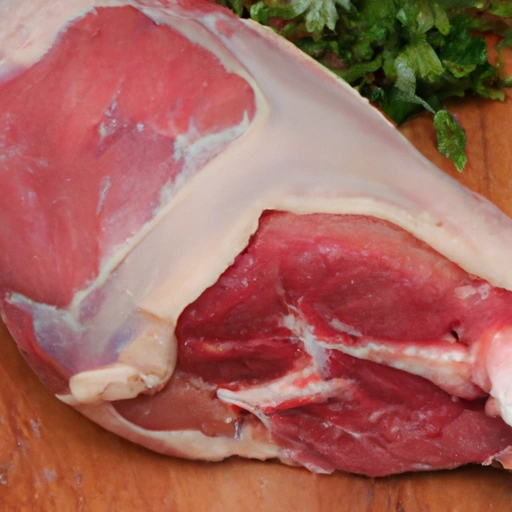Lamb Leg
Description

Lamb leg is a substantial and flavorful cut of meat that is highly regarded in cuisines around the world. This cut comes from the hindquarters of the animal and can be purchased bone-in, partially boned, or boneless. Lamb leg is known for its tender texture and rich, slightly gamey flavor, which has been celebrated in culinary traditions from the Mediterranean to the American continents. When it comes to measurements, chefs and home cooks can refer to both American (pounds and ounces) and European (grams and kilograms) units to portion and prepare this versatile ingredient for their recipes.
Common uses
Lamb leg is commonly used in a variety of dishes including roasted joints, stews, and grilled preparations. It's also a popular choice for slow-cooked meals, where its full flavor can develop and enhance the overall taste of the dish.
Nutritional value
Calories
A 3-ounce serving of cooked, trimmed lamb leg contains approximately 175 calories.
Protein
That same serving size offers about 23 grams of protein, making lamb leg a rich source of this essential nutrient.
Fat
Lamb leg contains around 8 grams of fat per 3-ounce serving, with a mix of saturated and unsaturated fats.
Carbohydrates
Lamb leg is naturally low in carbohydrates, with virtually zero grams per serving.
Vitamins
This meat is a good source of B-vitamins, particularly vitamin B12, which is critical for nerve function and the production of DNA and red blood cells.
Minerals
Lamb leg is also rich in minerals such as zinc, selenium, and iron, which play various roles in immune function and metabolism.
Health benefits
Due to its high protein content and valuable micronutrients, lamb leg can be a beneficial part of a balanced diet. It supports muscle growth and repair, and provides vitamins and minerals necessary for overall health.
Potential risks
However, like all red meats, lamb should be consumed in moderation. High intake of red meat has been associated with increased risk of certain health conditions, such as heart disease and certain cancers.
Common recipes
Lamb leg is often the star of recipes such as roasted leg of lamb with rosemary and garlic, slow-cooked Moroccan lamb tagine, or a Greek-style lamb gyro.
Cooking methods
It can be roasted, grilled, slow-cooked, or braised to achieve a variety of textures and flavors. When cooking lamb leg, it's important to monitor the internal temperature to ensure it reaches the desired level of doneness, which is often 145°F (63°C) for medium-rare.
Pairing with other ingredients
Lamb pairs beautifully with a range of flavors, from classic garlic and rosemary to bold spices like cumin and coriander. It also goes well with a variety of side dishes, including roasted vegetables, couscous, and mint sauce.
Summary
Lamb leg is a versatile and flavorful ingredient that plays an important role in many cuisines across the globe. With its rich history, nutritional value, and wide array of culinary applications, lamb leg is a favorite among chefs and home cooks alike. While it offers many health benefits, it should be consumed in moderation within a balanced diet. Whether roasted for a special occasion or stewed for a comforting meal, lamb leg is a delightful addition to any menu.